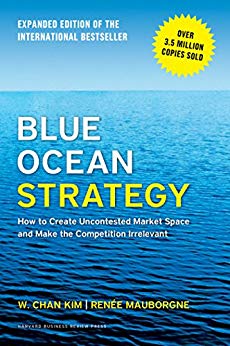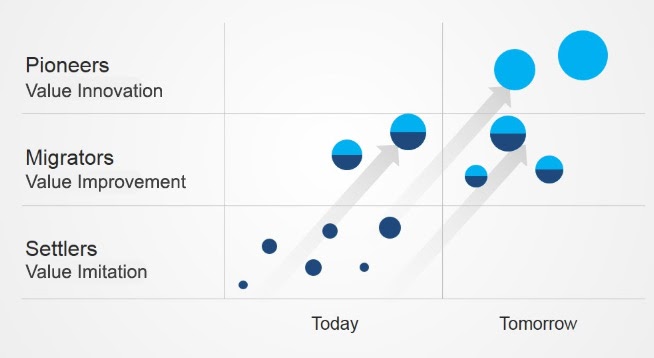

This article is an excerpt from the Shortform summary of "Blue Ocean Strategy" by W. Chan Kim and Renee Mauborgne. Shortform has the world's best summaries of books you should be reading.
Like this article? Sign up for a free trial here .
What is the Pioneer-Migrator-Settler Map? What does it mean for your business and Blue Ocean Strategy? Learn how you should have projects in each stage of the lifecycle, from pioneers to migrators to settler projects.
Another way to visualize your organization’s strategy is to plot all its projects on its level of innovation.
Companies have a portfolio of projects across the spectrum of innovation:
- Pioneers are blue ocean offerings
- Settlers are me-too businesses in the red ocean
- Migrators are in between – they may offer the customer more value, but don’t alter the industry’s basic shape
Plot your company’s projects along this spectrum. Ideally you have a healthy mix of all, with settlers and migrators serving as profit centers, and pioneers leading the company’s future growth.
As you practice blue ocean strategy thinking, the trajectory of your organization should shift toward a greater concentration in pioneers and migrators.

Renewing the Organization with Pioneers
When the blue ocean turns red and it’s difficult to value innovate further, then the company needs to look for more blue oceans to enter. This should be happening in parallel with extending blue oceans, so that when an older strategy reaches the end of its lifetime, the company has new pockets of growth. Thus the company maintains a portfolio of businesses at different stages of their life cycle – pioneers, migrators, and settlers.
The book cites Apple’s multiple rounds of blue ocean moves:
- In 1998 it simplified its product line and introduced the iMac, a colorful, intuitive computer rivaling drab PCs.
- In 2001 it introduced the iPod and in 2003 it introduced the iTunes Music Store, together considerably growing the market for digital music through convenience and branding.
- In 2007 it introduced the iPhone, revolutionizing the form factor of phones and becoming the first widely popular smartphone. It also spawned the App Store in 2008, creating an ecosystem of developers that further increased the value of its hardware products.
- In 2010 it introduced the iPad, further simplifying the interface to computing and further growing the market for apps and connection to the internet.
In every one of these moves, followers like Google, Samsung, and PC manufacturers quickly followed, developing ultrabooks, Android phones and tablets, and the Google Play store. A product that was once a pioneer eventually became a migrator.
The authors acknowledge that at maturity, red ocean strategy is critical to maximizing the longevity of a strategy. For instance, Apple launched a range of iPods at different price points to combat a range of competitor products. If your market is good enough, competition becomes inevitable. The key is to keep developing new blue oceans and pioneers to be the new drivers of business.
The challenge for long-lasting and companies with a diverse portfolio like Apple, General Electric, and Johnson & Johnson is to continuously value innovate to create profitable growth. At the time of the book’s writing, Microsoft was long considered largely to be largely milking its Office and Windows software, having failed to dominate major new spaces like search engines (Google), social networking (Facebook, Linkedin, Twitter), devices (Apple).
———End of Preview———

Like what you just read? Read the rest of the world's best summary of "Blue Ocean Strategy" at Shortform . Learn the book's critical concepts in 20 minutes or less .
Here's what you'll find in our full Blue Ocean Strategy summary :
- What blue oceans are, and how you create one for your business
- Why some businesses succeed in creating blue oceans, and why others fail
- The red ocean traps you have to avoid if you want business growth






